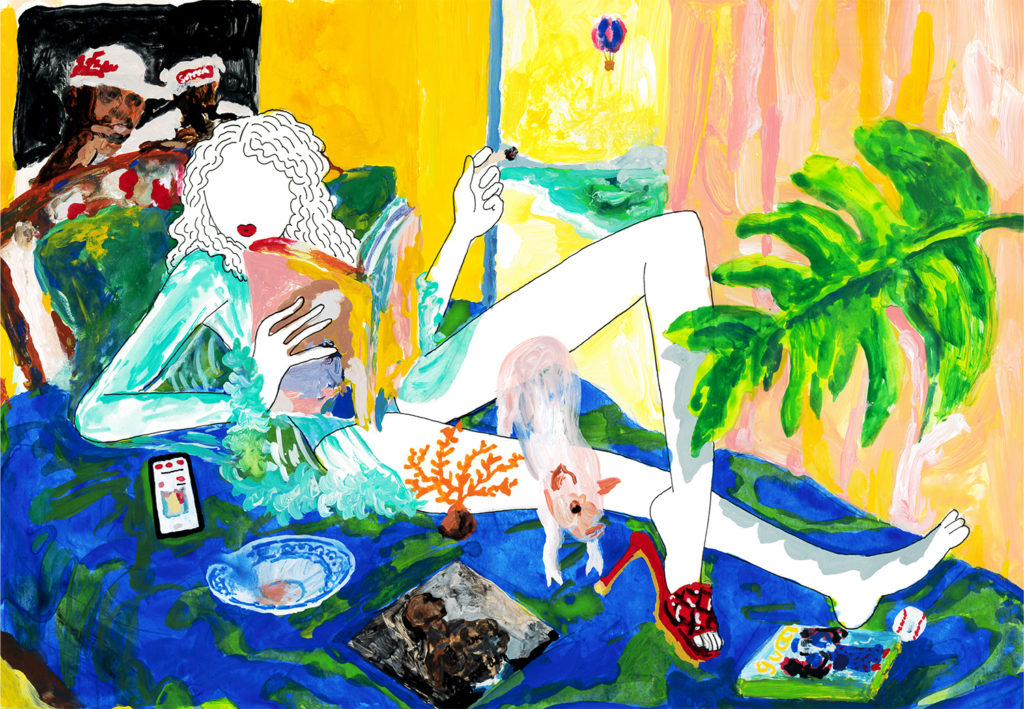When we look at the relationship between music and fashion, as well as between fashion trends and youth culture, we get a clearer understanding of the times we live in. In this series, Tsuya-chan, an up-and-coming writer, analyzes current cultural events by examining contemporary music with a focus on Japanese hip-hop.
Until now, this series has focused on a single brand. However, in the fourteenth installment, Tsuya-chan focuses on the item known as sneakers. Starting with changes in the depiction of sneakers, which have a special presence in hip hop, she will discuss the chain of metaphors and images spun through this item and the “essence of hip hop” that emerges.
Sneakers as a sacred motif
It’s like the roles that trains, bars, and mirrors play in film history.
It’s like how the movement of the hanging white laundry that flutters in the yard—beyond the softly, eerily swaying curtains—does not only convey the fact that the wind is blowing. It also connects to our memories of various films, moving our hearts and slowly inducing a sweet spasm in our bodies.
In hip hop history, sneakers are a special and sacred motif, an item, simultaneously a detail and everything. Immediately, my hands grab a record called Sora Kara No Chikara. From that track, which isn’t exactly the best audio quality, I hear the following rap:
“Historic music/Run-D.M.C., KRS, Rakim, Chuck D/I could never forget ‘87/Even when I remember it now, it’s crazy/Adidas from head to toe/Weaving together moves no one had ever seen”
-From “Yukue Fumei”, 1995
Here, “Adidas” is rhymed with “Amidasu” [“Weaving together”], a brilliant display of the rapper’s skill in dramatically describing sneakers. Years later, K Dub Shine similarly rhymed, “Top and bottom Adidas/Kangol hat/Superstars with no laces/Standing with arms crossed/I memorized and sang/ “You Talk Too Much,” Fly Girl,” “Nightmare,” “Just Buggin Lali Dadi” (Shoushin Shoumei). The image he mentions—of RUN-D.M.C. wearing Adidas track jackets with laceless Superstars—is still known by many people. But the word “weaving” in the previously mentioned passage makes me envision the action of tying a sneaker’s laces. Moreover, I think this is linked to the action of rappers, DJs, and dancers weaving their own brilliant techniques. In this way, sneakers were depicted as an important device in Japanese rap, and later, many stories would be created.
Additionally, citing equally important lines by Twigy and DABO, the sacredness of sneakers in hip hop history is also referenced in the following passage:
“Even besides RUN-D.M.C.’s “My Adidas” and “Mainichi Migaku Sneaker to Skill” (Twigy), a love for sneakers is very characteristic of old-school hip hop. For example, I recall that DABO sang about something similar with, ‘Hey kid, watch out/If you step on my Nikes, that’s an immediate death sentence’ (“Mischief” by Nitro Microphone Underground).
-From “Infumi Otto ni Yoru Nihongo Rap Blog”
When luxury and street began to intersect
Sneakers are such a sacred item that there is the threat of “an immediate death sentence” if they’re stepped on. Yet, so many brands are accepted that in COMA-CHI’s “me & my kicks,” he says, “Vans/Adidas/Nike/Reebok/Regardless of the brand, what’s good is good.” On the other hand, until a certain era, luxury brands were rarely coordinated with sneaker brands. As Kick the Can Crew says in “3MCS+1DJ”: “Nike over Prada/Adidas over Gucci/Wearing it and spitting party rap.” It wasn’t until the mid-2010s, when high fashion began to boldly incorporate street style, that the times changed.
In 2015, KOHH mentions Adidas collaboration with Yohji Yamamoto in “Dirt Boys feat.Dutch Montana & Loota”: “Filthy, but I’m still lookin’ fresh/Artistic, tats all up on my neck/Damaged denim Ksubi, is how I’m dressed/Shirts by Y-3, clothes every month I cop too many.” And G.RINA sang in “close2u” in 2017: “Dressed down/White Adidas.” Adidas became something that could be worn with dressy clothes to make them more casual, and the boundary between high fashion and street began to disappear. Later, in the 2021 song “BEAST MODE feat. JP THE WAVY,” Leon Fanourakis describes sneakers: “Nike grails/Everything I just bought is the latest.” Since the time when Black people didn’t have the money to buy expensive sneakers and cleaned a pair of sneakers over and over to keep them bright white, rappers have risen to the level that they not only can buy new sneakers, but multiple pairs of expensive sneakers. It’s gotten to the point where the musician Mom wrote with a tinge of irony, “Black jeans I wear all the time/Dropkick yesterday’s coward/I’m not a dreamer or a realist/Nike or Mizuno, it doesn’t matter/The value of things is what chokes.” (“Mom no Daycatch”) For now, we can use this to summarize the changing portrayal of sneakers within lyrics.
”Bright white sneakers” are full of associations and metaphors
However, the purpose of this article is not to trace the evolution of how sneakers are portrayed in lyrics. Here’s what I want to discuss: How the white sneaker has layers upon layers of associations and metaphors, intertwining with the backdrop of hip hop and Japanese rap and opening the door for all races and generations. For example, if we reflect upon the following verse from OMSB’s “CLOWN,” which was released to critical acclaim this year, it helps us unravel the story:
“A vision of mixed emotions/Beautiful women don’t even notice me/White Nikes stepped on in a frenzy/Sigh at everything, my music/Fuck it”
「The “naishi” in “mimukimoshinaishi” [“Don’t even notice me”], the “iki” in “ikiri” [“frenzy”], “iki” in “tameiki” [“sigh”], “myuji” in “myujikku” [“music”], and “Nike” all rhyme, and the verse is concluded with “Fuck it.” These lines reveal once again how sacred white Nikes are. However, the “Nikes” here do not refer only to the fact that he is wearing new sneakers. OMSB wrote the following lines, which provide a contrast to the whiteness of the sneakers:
“A freak show of ego monsters/A strange prison where shame feeds art/A beautiful person/A color that isn’t skin/The internal is external/You can tell if you look closely/No matter how cheerful he acts, he’s a scumbag/A black tone but such a sweet guy”
Here, black is depicted as a contrast to white. OMSB utters the phrases “A color that isn’t skin” and “A black tone.” Here, another meaning of the “white” of white sneakers emerges. It becomes clear that white has a very important significance as a contrast to black. To add to this, the phrase “Yellow cheers spread,” inserted towards the end of the song could be heard as a metaphor for a certain race.
The perpetual reversal of black and white with sneakers as well as pen & paper
The lyrics don’t end there. Let me raise another example. We must not forget another important item related to “white” in Japanese rap history. Cypress Ueno To Roberto Yoshino’s “RUN AND GUN feat LEON a.k.a. SHISHI, DOLLARBILL” presented an accurate depiction of this color.
“Like always, I throw my empty contents onto a blank white paper/In these moments alone, anyone is a young boy/Where I want to be is always far away
My shoes keep going even if the heels wear out/I’ll pay back the debt I owe with color/I’m still up there, not down there/Even if it’s just lip service/I’ll connect this relay
Run faster than usual/Run and gun/If you’re chasing your dreams, for real/Run and gun
Kanye Jay Z are the roots, the beginning/Wearing loose clothes/My thing back then/Walking in the hood with Nike shoes”
“Blank white paper.” In this song, both sacred white items—“blank white paper” and “sneakers”—are depicted. They walk in the hood wearing sneakers with worn-out heels, stringing together lyrics on blank white paper, and where they want to be is far off in the distance. Run and gun—to run swiftly. It’s just as Soul Scream once wrote in “Brand New feat. RHYMESTER”: “My tool is/A white paper and pen/ I only recognize words of my choice.” These lines show that as long as one has a worn-out (but white!) pair of sneakers and a blank white (but filled with black pen!) paper, rap is open to anyone. The essence of hip hop lies in the repeated reversal of black and white: Sneakers that have been cleaned over and over to preserve their whiteness and blank white paper filled with black lyrics.
A record travels. It effortlessly transcends time. The times have changed, and rappers’ white sneakers have gone from one polished pair to multiple pairs of new sneakers. However, the sacredness of white will not change in the slightest as long as those who love hip hop—who are attracted to the culture and music and come knocking at the door regardless of race, generation, and class—continue to wear white sneakers and eagerly fill up blank sheets of paper with lyrics. That’s precisely why they clean their sneakers. Move their pens. And get pair after pair of bright white sneakers. Speed up the reversal of black and white. Spin the records. Use loops to create a groove. Run and gun—aim for a place far into the distance and start running.
Illustration AUTO MOAI
Translation Aya Apton


